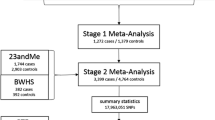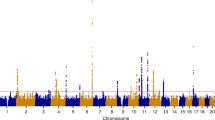Abstract
Uterine fibroids disproportionately impact Black women. Evidence suggests Black women have earlier onset and higher cumulative risk. This risk disparity may be due an imbalance of risk alleles in one parental geographic ancestry subgroup relative to others. We investigated ancestry proportions for the 1000 Genomes phase 3 populations clustered into six geographic groups for association with fibroid traits in Black women (n = 583 cases, 797 controls) and White women (n = 1195 cases, 1164 controls). Global ancestry proportions were estimated using ADMIXTURE. Dichotomous (fibroids status and multiple fibroid status) and continuous outcomes (volume and largest dimension) were modeled for association with ancestry proportions using logistic and linear regression adjusting for age. Effect estimates are reported per 10% increase in genetically inferred ancestry proportion. Among Black women, West African (WAFR) ancestry was associated with fibroid risk, East African ancestry was associated with risk of multiple fibroids, Northern European (NEUR) ancestry was protective for multiple fibroids, Southern European ancestry was protective for fibroids and multiple fibroids, and South Asian (SAS) ancestry was positively associated with volume and largest dimension. In White women, NEUR ancestry was protective for fibroids, SAS ancestry was associated with fibroid risk, and WAFR ancestry was positively associated with volume and largest dimension. These results suggest that a proportion of fibroid risk and fibroid trait racial disparities are due to genetic differences between geographic groups. Further investigation at the local ancestry and single variant levels may yield novel insights into disease architecture and genetic mechanisms underlying ethnic disparities in fibroid risk.




Similar content being viewed by others
Data availability
The data underlying this article will be shared on reasonable request to the corresponding author.
Code availability
The code underlying this article will be shared on reasonable request to the corresponding author.
References
Alexander DH, Lange K (2011) Enhancements to the ADMIXTURE algorithm for individual ancestry estimation. BMC Bioinformatics 12:246
Alexander DH, Novembre J, Lange K (2009) Fast model-based estimation of ancestry in unrelated individuals. Genome Res 19:1655–1664
August P, Suthanthiran M (2003) Transforming growth factor beta and progression of renal disease. Kidney Int Suppl 64:S99–S104
Baird DD, Dunson DB, Hill MC, Cousins D, Schectman JM (2003) High cumulative incidence of uterine leiomyoma in black and white women: ultrasound evidence. Am J Obstet Gynecol 188:100–107
Barnes KC, Grant AV, Hansel NN, Gao P, Dunston GM (2007) African Americans with asthma: genetic insights. Proc Am Thorac Soc 4:58–68
Bray MJ, Edwards TL, Wellons MF, Jones SH, Hartmann KE, Velez Edwards DR (2017) Admixture mapping of uterine fibroid size and number in African American women. Fertil Steril 108:1034-1042.e26
Cardozo ER, Clark AD, Banks NK, Henne MB, Stegmann BJ, Segars JH (2012) The estimated annual cost of uterine leiomyomata in the United States. Am J Obstet Gynecol 206(211):e211–e219
Chang CC, Chow CC, Tellier LC, Vattikuti S, Purcell SM, Lee JJ (2015) Second-generation PLINK: rising to the challenge of larger and richer datasets. Gigascience 4:7
Ciavattini A, Di Giuseppe J, Stortoni P, Montik N, Giannubilo SR, Litta P, Islam MS, Tranquilli AL, Reis FM, Ciarmela P (2013) Uterine fibroids: pathogenesis and interactions with endometrium and endomyometrial junction. Obstet Gynecol Int 2013:173184
Commandeur AE, Styer AK, Teixeira JM (2015) Epidemiological and genetic clues for molecular mechanisms involved in uterine leiomyoma development and growth. Hum Reprod Update 21:593–615
Cramer SF, Patel A (1990) The frequency of uterine leiomyomas. Am J Clin Pathol 94:435–438
Dustan HP (1992) Growth factors and racial differences in severity of hypertension and renal diseases. Lancet 339:1339–1340
Feingold-Link L, Edwards TL, Jones S, Hartmann KE, Velez Edwards DR (2014) Enhancing uterine fibroid research through utilization of biorepositories linked to electronic medical record data. J Womens Health (larchmt) 23:1027–1032
Flake GP, Andersen J, Dixon D (2003) Etiology and pathogenesis of uterine leiomyomas: a review. Environ Health Perspect 111:1037–1054
Giri A, Edwards TL, Hartmann KE, Torstenson ES, Wellons M, Schreiner PJ, Velez Edwards DR (2017) African genetic ancestry interacts with body mass index to modify risk for uterine fibroids. PLoS Genet 13:e1006871
Hellwege JN, Torstenson ES, Russell SB, Edwards TL, Velez Edwards DR (2017) Evidence of selection as a cause for racial disparities in fibroproliferative disease. PLoS ONE 12:e0182791
Huang C, Ogawa R (2012) Fibroproliferative disorders and their mechanobiology. Connect Tissue Res 53:187–196
Kjerulff KH, Langenberg P, Seidman JD, Stolley PD, Guzinski GM (1996) Uterine leiomyomas. Racial differences in severity, symptoms and age at diagnosis. J Reprod Med 41:483–490
Laughlin SK, Baird DD, Savitz DA, Herring AH, Hartmann KE (2009) Prevalence of uterine leiomyomas in the first trimester of pregnancy: an ultrasound-screening study. Obstet Gynecol 113:630–635
Lester LA, Rich SS, Blumenthal MN, Togias A, Murphy S, Malveaux F, Miller ME, Dunston GM, Solway J, Wolf RL et al (2001) Ethnic differences in asthma and associated phenotypes: collaborative study on the genetics of asthma. J Allergy Clin Immunol 108:357–362
Lippman SA, Warner M, Samuels S, Olive D, Vercellini P, Eskenazi B (2003) Uterine fibroids and gynecologic pain symptoms in a population-based study. Fertil Steril 80:1488–1494
Marshall LM, Spiegelman D, Barbieri RL, Goldman MB, Manson JE, Colditz GA, Willett WC, Hunter DJ (1997) Variation in the incidence of uterine leiomyoma among premenopausal women by age and race. Obstet Gynecol 90:967–973
Mayes MD, Lacey JV Jr, Beebe-Dimmer J, Gillespie BW, Cooper B, Laing TJ, Schottenfeld D (2003) Prevalence, incidence, survival, and disease characteristics of systemic sclerosis in a large US population. Arthritis Rheum 48:2246–2255
Morris DA, Peracha MO, Shin DH, Kim C, Cha SC, Kim YY (1999) Risk factors for early filtration failure requiring suture release after primary glaucoma triple procedure with adjunctive mitomycin. Arch Ophthalmol 117:1149–1154
Murray T, Beaty TH, Mathias RA, Rafaels N, Grant AV, Faruque MU, Watson HR, Ruczinski I, Dunston GM, Barnes KC (2010) African and non-African admixture components in African Americans and an African Caribbean population. Genet Epidemiol 34:561–568
Newth CJ, Meert KL, Clark AE, Moler FW, Zuppa AF, Berg RA, Pollack MM, Sward KA, Berger JT, Wessel DL et al (2012) Fatal and near-fatal asthma in children: the critical care perspective. J Pediatr 161:214-221.e3
Nickel R, Beck LA, Stellato C, Schleimer RP (1999) Chemokines and allergic disease. J Allergy Clin Immunol 104:723–742
Niessen FB, Spauwen PH, Schalkwijk J, Kon M (1999) On the nature of hypertrophic scars and keloids: a review. Plast Reconstr Surg 104:1435–1458
Polednak AP (1987) Connective tissue responses in blacks in relation to disease: further observations. Am J Phys Anthropol 74:357–371
R Core Team (2015) R: A language and environment for statistical computing. R Foundation for Statistical Computing, Austria, Vienna
Racette L, Wilson MR, Zangwill LM, Weinreb RN, Sample PA (2003) Primary open-angle glaucoma in blacks: a review. Surv Ophthalmol 48:295–313
Richman IB, Taylor KE, Chung SA, Trupin L, Petri M, Yelin E, Graham RR, Lee A, Behrens TW, Gregersen PK et al (2012) European genetic ancestry is associated with a decreased risk of lupus nephritis. Arthritis Rheum 64:3374–3382
Roden DM, Pulley JM, Basford MA, Bernard GR, Clayton EW, Balser JR, Masys DR (2008) Development of a large-scale de-identified DNA biobank to enable personalized medicine. Clin Pharmacol Ther 84:362–369
Ross RK, Pike MC, Vessey MP, Bull D, Yeates D, Casagrande JT (1986) Risk factors for uterine fibroids: reduced risk associated with oral contraceptives. Br Med J (clin Res Ed) 293:359–362
Russell SB, Smith JC, Huang M, Trupin JS, Williams SM (2015) Pleiotropic effects of immune responses explain variation in the prevalence of fibroproliferative diseases. PLoS Genet 11:e1005568
Ryan GL, Syrop CH, Van Voorhis BJ (2005) Role, epidemiology, and natural history of benign uterine mass lesions. Clin Obstet Gynecol 48:312–324
Rybicki BA, Maliarik MJ, Major M, Popovich J Jr, Iannuzzi MC (1998) Epidemiology, demographics, and genetics of sarcoidosis. Semin Respir Infect 13:166–173
Sato F, Mori M, Nishi M, Kudo R, Miyake H (2002) Familial aggregation of uterine myomas in Japanese women. J Epidemiol 12:249–253
Suthanthiran M, Li B, Song JO, Ding R, Sharma VK, Schwartz JE, August P (2000) Transforming growth factor-beta 1 hyperexpression in African-American hypertensives: a novel mediator of hypertension and/or target organ damage. Proc Natl Acad Sci USA 97:3479–3484
Vikhlyaeva EM, Khodzhaeva ZS, Fantschenko ND (1995) Familial predisposition to uterine leiomyomas. Int J Gynaecol Obstet 51:127–131
Wallach EE, Vlahos NF (2004) Uterine myomas: an overview of development, clinical features, and management. Obstet Gynecol 104:393–406
Wechter ME, Stewart EA, Myers ER, Kho RM, Wu JM (2011) Leiomyoma-related hospitalization and surgery: prevalence and predicted growth based on population trends. Am J Obstet Gynecol 205(492):e491–e495
Whiteman MK, Hillis SD, Jamieson DJ, Morrow B, Podgornik MN, Brett KM, Marchbanks PA (2008) Inpatient hysterectomy surveillance in the United States, 2000–2004. Am J Obstet Gynecol 198(34):e31–e37
Wise LA, Ruiz-Narvaez EA, Palmer JR, Cozier YC, Tandon A, Patterson N, Radin RG, Rosenberg L, Reich D (2012) African ancestry and genetic risk for uterine leiomyomata. Am J Epidemiol 176:1159–1168
Zhang K, Wiener H, Aissani B (2015) Admixture mapping of genetic variants for uterine fibroids. J Hum Genet 60:533–538
Zimmermann A, Bernuit D, Gerlinger C, Schaefers M, Geppert K (2012) Prevalence, symptoms and management of uterine fibroids: an international internet-based survey of 21,746 women. BMC Womens Health 12:6
Funding
The BioVU dataset used for the analyses described was obtained from Vanderbilt University Medical Center’s BioVU which is supported by institutional funding and by the Vanderbilt CTSA grant ULTR000445 from NCATS/NIH. D.R.V.E. was supported by National Institute of Health grants R01HD074711, R01HD093671, and R03HD078567. J.N.H. was supported by K12HD04348 (PI K.E. Hartmann). J.M.K. and E.A.J. were supported by the National Human Genome Research Institute training grant 5T32HG008341.
Author information
Authors and Affiliations
Contributions
JMK assisted with analysis and drafting manuscript. EAJ assisted with analysis and drafting manuscript. JNH assisted with analysis and data quality control and edited the final draft. SHJ assisted with data management and edited final draft. EST assisted with data management and quality controls and edited final draft. TLE helped develop the study design and analysis plan and edited the manuscript. DRV Edwards helped develop the study design and analysis plan and edited the manuscript.
Corresponding author
Ethics declarations
Conflict of interest
There are no conflicts of interest relevant to this article.
Ethics approval
The study was approved by the Institutional Review Board at Vanderbilt University Medical Center (#110407).
Additional information
Publisher's Note
Springer Nature remains neutral with regard to jurisdictional claims in published maps and institutional affiliations.
Supplementary Information
Below is the link to the electronic supplementary material.
Rights and permissions
About this article
Cite this article
Keaton, J.M., Jasper, E.A., Hellwege, J.N. et al. Evidence that geographic variation in genetic ancestry associates with uterine fibroids. Hum Genet 140, 1433–1440 (2021). https://doi.org/10.1007/s00439-021-02322-y
Received:
Accepted:
Published:
Issue Date:
DOI: https://doi.org/10.1007/s00439-021-02322-y




